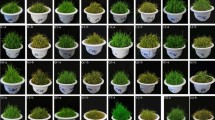Abstract
Eragrostis curvula is a perennial bunch grass widely used in South Africa. In order to determine the low-temperature tolerance of this grass, the following experiment was carried out. Twenty dormant stools of E. curvula (‘Ermelo’ variety), cut to within 3 in. of the ground, were transplanted in the winter (May 28) of 1958 into 4-gal. tins, and watered. Ten of these tins were placed in an illuminated constant-temperature room at 31° C. (87.8° F.) on July 9. Active growth started within a day, and the plants reached a height of more than 12 in. within nineteen days. On July 28 the plants were grouped in pairs, each of which was subjected to one of the following temperatures for three days: − 16.7° C (2° F.), − 13.3° C. (8° F.), −12.2° C. (10° F.), −10.8° C (12.5° F.) and 1.7° C. (35° F.). They were then transferred to a glasshouse (at approximately 24° C. (75° F.)) for further observation. All stools had been killed by low temperature.
Similar content being viewed by others
References
Crider, F. J., U.S. Dept. Agric. Circ. No. 730 (1945).
Author information
Authors and Affiliations
Rights and permissions
About this article
Cite this article
LEIGH, J. Low-Temperature Injury in Lovegrass (Eragrostis curvula (Schrad) Nees). Nature 189, 415–416 (1961). https://doi.org/10.1038/189415a0
Issue Date:
DOI: https://doi.org/10.1038/189415a0
- Springer Nature Limited





